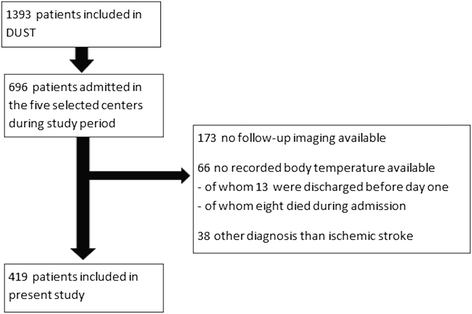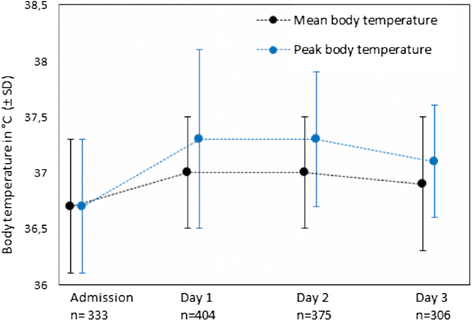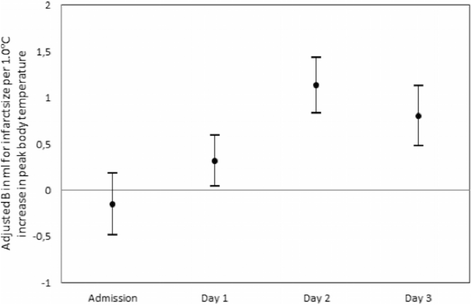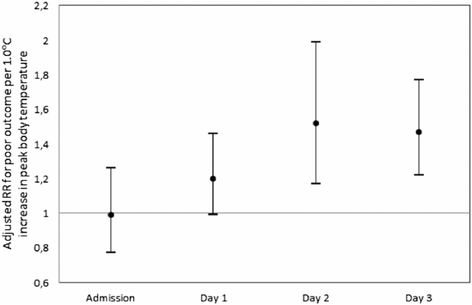Temporal profile of body temperature in acute ischemic stroke: relation to infarct size and outcome
- PMID: 27871258
- PMCID: PMC5117518
- DOI: 10.1186/s12883-016-0760-7
Temporal profile of body temperature in acute ischemic stroke: relation to infarct size and outcome
Abstract
Background: High body temperatures after ischemic stroke have been associated with larger infarct size, but the temporal profile of this relation is unknown. We assess the relation between temporal profile of body temperature and infarct size and functional outcome in patients with acute ischemic stroke.
Methods: In 419 patients with acute ischemic stroke we assessed the relation between body temperature on admission and during the first 3 days with both infarct size and functional outcome. Infarct size was measured in milliliters on CT or MRI after 3 days. Poor functional outcome was defined as a modified Rankin Scale score ≥3 at 3 months.
Results: Body temperature on admission was not associated with infarct size or poor outcome in adjusted analyses. By contrast, each additional 1.0 °C in body temperature on day 1 was associated with 0.31 ml larger infarct size (95% confidence interval (CI) 0.04-0.59), on day 2 with 1.13 ml larger infarct size(95% CI, 0.83-1.43), and on day 3 with 0.80 ml larger infarct size (95% CI, 0.48-1.12), in adjusted linear regression analyses. Higher peak body temperatures on days two and three were also associated with poor outcome (adjusted relative risks per additional 1.0 °C in body temperature, 1.52 (95% CI, 1.17-1.99) and 1.47 (95% CI, 1.22-1.77), respectively).
Conclusions: Higher peak body temperatures during the first days after ischemic stroke, rather than on admission, are associated with larger infarct size and poor functional outcome. This suggests that prevention of high temperatures may improve outcome if continued for at least 3 days.
Keywords: Body temperature; Cerebral infarction; Hypothermia.
Figures
Similar articles
-
Body temperature in acute stroke: relation to stroke severity, infarct size, mortality, and outcome.Lancet. 1996 Feb 17;347(8999):422-5. doi: 10.1016/s0140-6736(96)90008-2. Lancet. 1996. PMID: 8618482
-
Functional recovery in ischemic stroke.Neurol India. 2003 Sep;51(3):414-6. Neurol India. 2003. PMID: 14652460
-
Temporal profile of body temperature in acute ischemic stroke: relation to stroke severity and outcome.BMC Neurol. 2012 Oct 18;12:123. doi: 10.1186/1471-2377-12-123. BMC Neurol. 2012. PMID: 23075282 Free PMC article.
-
Early infarct growth predicts long-term clinical outcome in ischemic stroke.J Neurol Sci. 2014 Dec 15;347(1-2):205-9. doi: 10.1016/j.jns.2014.09.048. Epub 2014 Oct 2. J Neurol Sci. 2014. PMID: 25304056
-
Dichotomous effects of autophagy on infarct volume in experimental permanent/transient ischemic stroke model: a systematic review and meta-analysis.J Integr Neurosci. 2022 Jan 28;21(1):11. doi: 10.31083/j.jin2101011. J Integr Neurosci. 2022. PMID: 35164447
Cited by
-
Body temperature in the acute phase and clinical outcomes after acute ischemic stroke.PLoS One. 2024 Jan 11;19(1):e0296639. doi: 10.1371/journal.pone.0296639. eCollection 2024. PLoS One. 2024. PMID: 38206979 Free PMC article.
-
Potential Factors for Psychological Symptoms at Three Months in Patients with Young Ischemic Stroke.Biomed Res Int. 2021 Feb 9;2021:5545078. doi: 10.1155/2021/5545078. eCollection 2021. Biomed Res Int. 2021. Retraction in: Biomed Res Int. 2024 Mar 20;2024:9764670. doi: 10.1155/2024/9764670. PMID: 33628789 Free PMC article. Retracted.
-
Acute Cardiovascular Changes Following Cerebral Ischemia in a Non-human Primate Thromboembolic Stroke Model.In Vivo. 2025 Jul-Aug;39(4):1992-2003. doi: 10.21873/invivo.13996. In Vivo. 2025. PMID: 40579037 Free PMC article.
-
PRECIOUS: PREvention of Complications to Improve OUtcome in elderly patients with acute Stroke-statistical analysis plan of a randomised, open, phase III, clinical trial with blinded outcome assessment.Trials. 2020 Oct 26;21(1):884. doi: 10.1186/s13063-020-04717-0. Trials. 2020. PMID: 33106180 Free PMC article. Clinical Trial.
-
Dynamic protein expression of NF-κB following rat intracerebral hemorrhage and its association with apoptosis.Exp Ther Med. 2018 Nov;16(5):3903-3908. doi: 10.3892/etm.2018.6715. Epub 2018 Sep 10. Exp Ther Med. 2018. PMID: 30344667 Free PMC article.
References
-
- Luengo-Fernandez R, Paul NL, Gray AM, Pendlebury ST, Bull LM, Welch SJ, et al. Population-based study of disability and institutionalization after transient ischemic attack and stroke: 10-year results of the Oxford Vascular Study. Stroke. 2013;44:2854–2861. doi: 10.1161/STROKEAHA.113.001584. - DOI - PMC - PubMed
MeSH terms
LinkOut - more resources
Full Text Sources
Other Literature Sources
Medical





